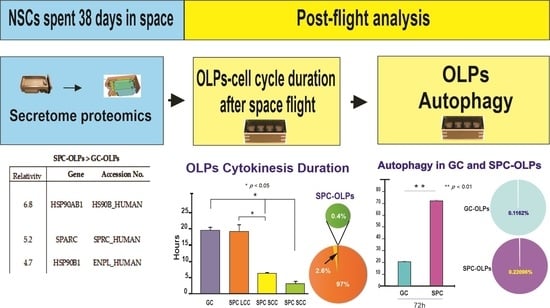Oligodendrocyte Progenitors Display Enhanced Proliferation and Autophagy after Space Flight
Abstract
1. Introduction
2. Methods
2.1. Cells and Culture System
2.2. Hardware and Space Flight
2.3. Time-Lapse of SPC-OLPs Behavior after Space Flight
2.4. Secretome Collection and Proteomics Analysis
2.5. Secretome Proteomic Profile
2.6. IEF and SDS-PAGE
2.7. Image Scan and Data Analysis
2.8. Spot Picking and Trypsin Digestion
2.9. Mass Spectrometry
2.10. Database Search
2.11. Statistics
3. Results
3.1. Space-Flown OLPs Consisted of Three Distinct Sub-Populations
3.2. Space Flight Upregulates Autophagy in OLPs
3.3. Secretome Proteomics
4. Discussion
4.1. OLPs Cytokinesis after Space Flight
4.2. Enhanced Autophagy in SPC-OLPs
4.3. Benefits Expected for Astronauts Living and Working in Microgravity
4.4. Benefits Expected for Humanity on Earth
Author Contributions
Funding
Institutional Review Board Statement
Informed Consent Statement
Data Availability Statement
Acknowledgments
Conflicts of Interest
Abbreviations
| ICP | Intracranial hypertension |
| VIIP | Visual impairment intracranial pressure |
| GC | Ground control |
| SPC | Space flown |
| HSP-90β | Heat shock protein-90 beta |
| SPARC | Secreted protein acidic and rich in cysteine |
| CNS | Central nervous system |
| OLPs | Oligodendrocyte progenitors |
| Sim-μG | Simulated microgravity |
| μG | Microgravity |
| GC | Ground control |
| NSCs | Neural stem cells |
| DM | Dorsomorphin |
| OSM | Oligodendrocyte specification medium |
| OSMc | Oligodendrocyte specification medium complete |
| OSMb | Oligodendrocyte specification medium basal |
| WM | Welcoming medium |
| ISS | International space station |
| STAaRS F-1 | Space technology and advanced research system experiment Facility-1 |
| LCC | Long cell cycle |
| SCC | Short cell cycle |
| TL | Time lapse |
| OL | Oligodendroglia |
| RPMs | Random positioning machines |
| ER | Endothelial reticulum |
References
- Espinosa-Jeffrey, A.; Paez, P.M.; Cheli, V.T.; Spreuer, V.; Wanner, I.; de Vellis, J. Impact of simulated microgravity on oligodendrocyte development: Implications for central nervous system repair. PLoS ONE 2013, 8, e76963. [Google Scholar] [CrossRef]
- Espinosa-Jeffrey, A.; Blanchi, B.; Biancotti, J.C.; Kumar, S.; Hirose, M.; Mandefro, B.; Talavera-Adame, D.; Benvenisty, N.; de Vellis, J. Efficient generation of viral and integration-free human induced pluripotent stem cell-derived oligodendrocytes. Curr. Protoc. Stem Cell Biol. 2016, 38, 2D.18.1–2D.18.27. [Google Scholar] [CrossRef]
- Tran, V.; Carpo, N.; Shaka, S.; Zamudio, J.; Choi, S.; Cepeda, C.; Espinosa-Jeffrey, A. Delayed Maturation of Oligodendrocyte Progenitors by Microgravity: Implications for Multiple Sclerosis and Space Flight. Life 2022, 12, 797. [Google Scholar] [CrossRef] [PubMed]
- Plett, P.A.; Abonour, R.; Frankovitz, S.M.; Orschell, C.M. Impact of modeled microgravity on migration, differentiation, and cell cycle control of primitive human hematopoietic progenitor cells. Exp. Hematol. 2004, 32, 773–781. [Google Scholar] [CrossRef]
- Silvano, M.; Miele, E.; Valerio, M.; Casadei, L.; Begalli, F.; Campese, A.; Mersini, Z.; Besharat, V.A.; Abballe, L.; Catanzaro, G.; et al. Consequences of Simulated Microgravity in Neural Stem Cells: Biological Effects and Metabolic Response. J. Stem Cell Res. Ther. 2015, 5, 289. [Google Scholar]
- Shaka, S.; Carpo, N.; Tran, V.; Ma, Y.Y.; Karouia, F.; Espinosa-Jeffrey, A. Human neural stem cells in space proliferate more than ground control cells: Implications for long-term space travel. J. Stem Cells Res. Dev. Ther. 2021, 7, 69. [Google Scholar]
- Shaka, S.; Carpo, N.; Tran, V.; Cepeda, C.; Espinosa-Jeffrey, A. Space Microgravity Alters Neural Stem Cell Division: Implications for Brain Cancer Research on Earth and in Space. Int. J. Mol. Sci. 2022, 23, 14320. [Google Scholar] [CrossRef] [PubMed]
- Qian, X.; Goderie, S.K.; Shen, Q.; Stern, J.H.; Temple, S. Intrinsic programs of patterned cell lineages in isolated vertebrate CNS ventricular zone cells. Development 1998, 125, 3143–3152. [Google Scholar] [CrossRef]
- Calver, A.R.; Hall, A.C.; Yu, W.P.; Walsh, F.S.; Heath, J.K.; Betsholtz, C.; Richardson, W.D. Oligodendrocyte population dynamics and the role of PDGF in vivo. Neuron 1998, 20, 869–882. [Google Scholar] [CrossRef]
- Neumann, B.; Kazanis, I. Oligodendrocyte progenitor cells: The ever mitotic cells of the CNS. Front. Biosci. 2016, 8, 29–43. [Google Scholar]
- Wolswijk, G.; Noble, M. Identification of an adult-specific glial progenitor cell. Development 1989, 105, 387–400. [Google Scholar] [CrossRef] [PubMed]
- Kuhn, S.; Gritti, L.; Crooks, D.; Dombrowski, Y. Oligodendrocytes in Development, Myelin Generation and Beyond. Cells 2019, 8, 1424. [Google Scholar] [CrossRef] [PubMed]
- Hoter, A.; El-Sabban, M.E.; Naim, H.Y. The HSP90 Family: Structure, Regulation, Function, and Implications in Health and Disease. Int. J. Mol. Sci. 2018, 19, 2560. [Google Scholar] [CrossRef] [PubMed]
- Jackson, S.E. Hsp90: Structure and function. Top. Curr. Chem. 2013, 328, 155–240. [Google Scholar] [PubMed]
- Li, W.; Sahu, D.; Tsen, F. Secreted heat shock protein-90 (Hsp90) in wound healing and cancer. Biochim. Biophys. Acta 2012, 1823, 730–741. [Google Scholar] [CrossRef]
- Levine, B.; Klionsky, D.J. Development by self-digestion: Molecular mechanisms and biological functions of autophagy. Dev. Cell 2004, 6, 463–477. [Google Scholar] [CrossRef]
- Scrivo, A.; Bourdenx, M.; Pampliega, O.; Cuervo, A.M. Selective autophagy as a potential therapeutic target for neurodegenerative disorders. Lancet Neurol. 2018, 17, 802–815. [Google Scholar] [CrossRef]
- Ondrej, M.; Cechakova, L.; Durisova, K.; Pejchal, J.; Tichy, A. To live or let die: Unclear task of autophagy in the radiosensitization battle. Radiother. Oncol. 2016, 119, 265–275. [Google Scholar] [CrossRef]
- Yunker, C.K.; Golembieski, W.; Lemke, N.; Schultz, C.R.; Cazacu, S.; Brodie, C.; Rempel, S.A. SPARC-induced increase in glioma matrix and decrease in vascularity are associated with reduced VEGF expression and secretion. Int. J. Cancer 2008, 122, 2735–2743. [Google Scholar] [CrossRef]
- Sailaja, G.S.; Bhoopathi, P.; Gorantla, B.; Chetty, C.; Gogineni, V.R.; Velpula, K.K.; Goni, C.S.; Rao, J.S. The secreted protein acidic and rich in cysteine (SPARC) induces endoplasmic reticulum stress leading to autophagy-mediated apoptosis in neuroblastoma. Int. J. Oncol. 2013, 42, 188–196. [Google Scholar] [CrossRef]
- Morabito, C.; Guarnieri, S.; Catizone, A.; Schiraldi, C.; Ricci, G.; Mariggiò, M.A. Transient increases in intracellular calcium and reactive oxygen species levels in TCam-2 cells exposed to microgravity. Sci. Rep. 2017, 7, 15648. [Google Scholar] [CrossRef] [PubMed]
- Sambandam, Y.; Townsend, M.T.; Pierce, J.J.; Lipman, C.M.; Haque, A.; Bateman, T.A.; Reddy, S.V. Microgravity control of autophagy modulates osteoclastogenesis. Bone 2014, 61, 125–131. [Google Scholar] [CrossRef] [PubMed]
- Li, C.F.; Pan, Y.K.; Gao, Y.; Shi, F.; Wang, Y.C.; Sun, X.Q. Autophagy protects HUVECs against ER stress-mediated apoptosis under simulated microgravity. Apoptosis 2019, 24, 812–825. [Google Scholar] [CrossRef] [PubMed]
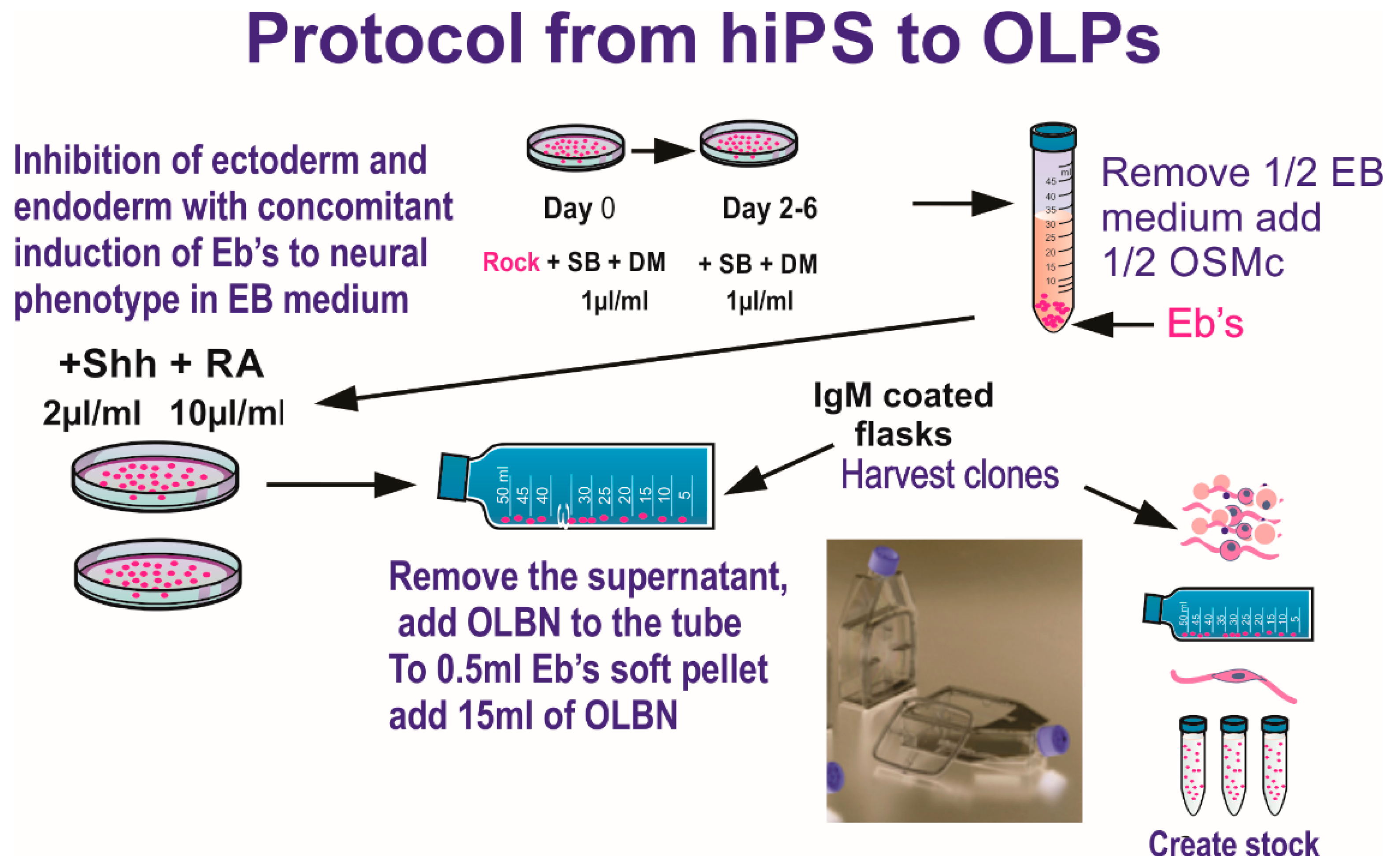
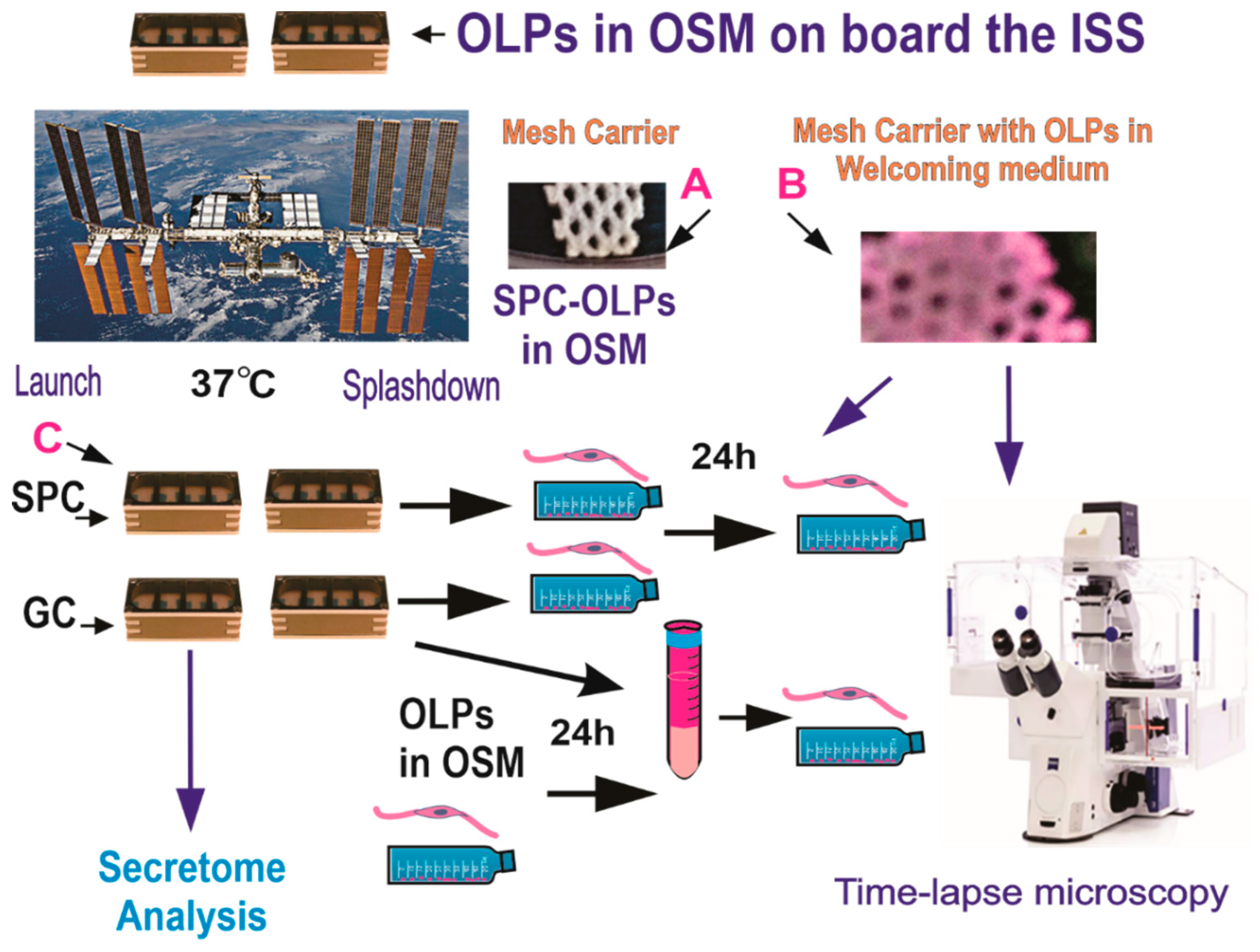

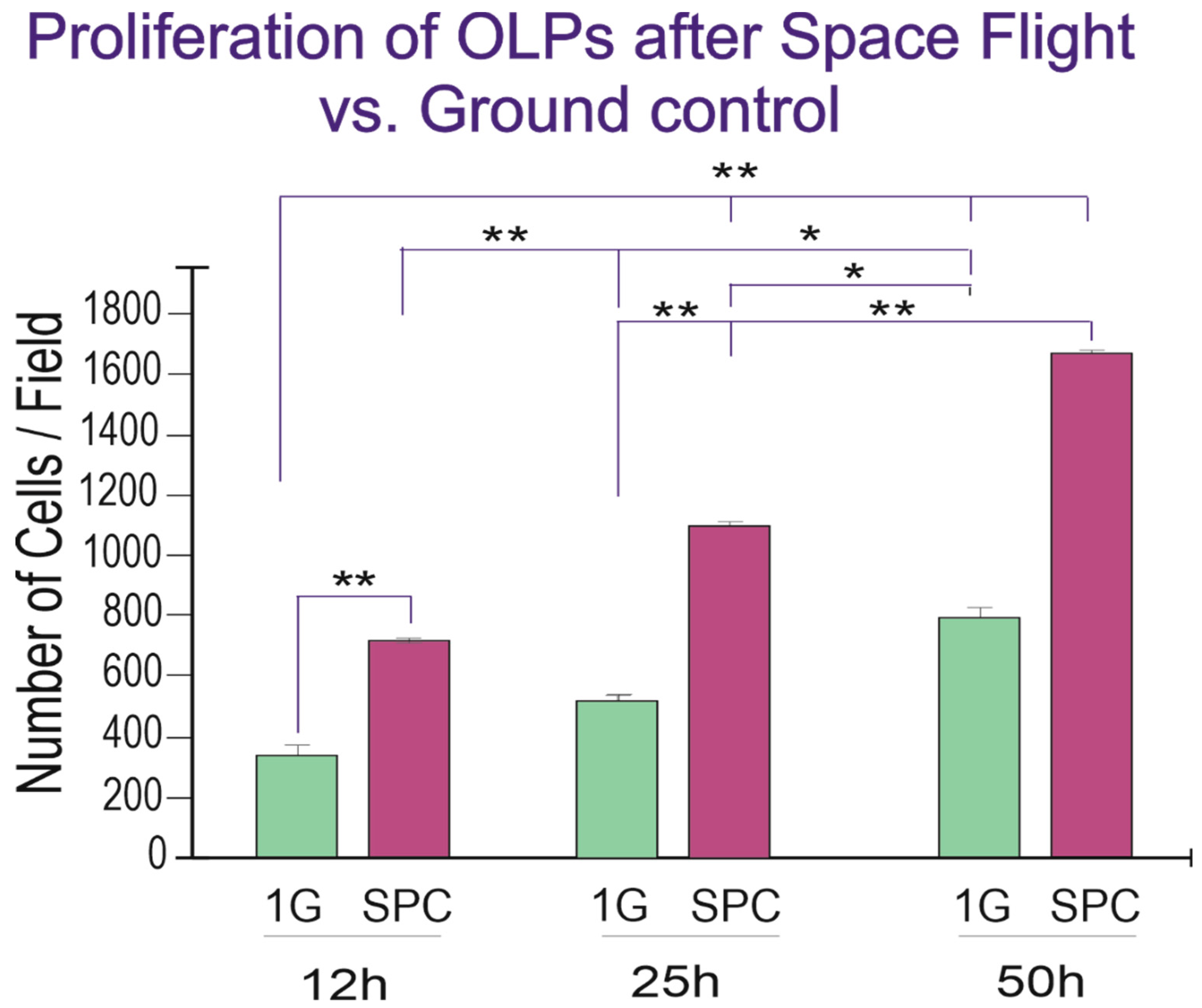
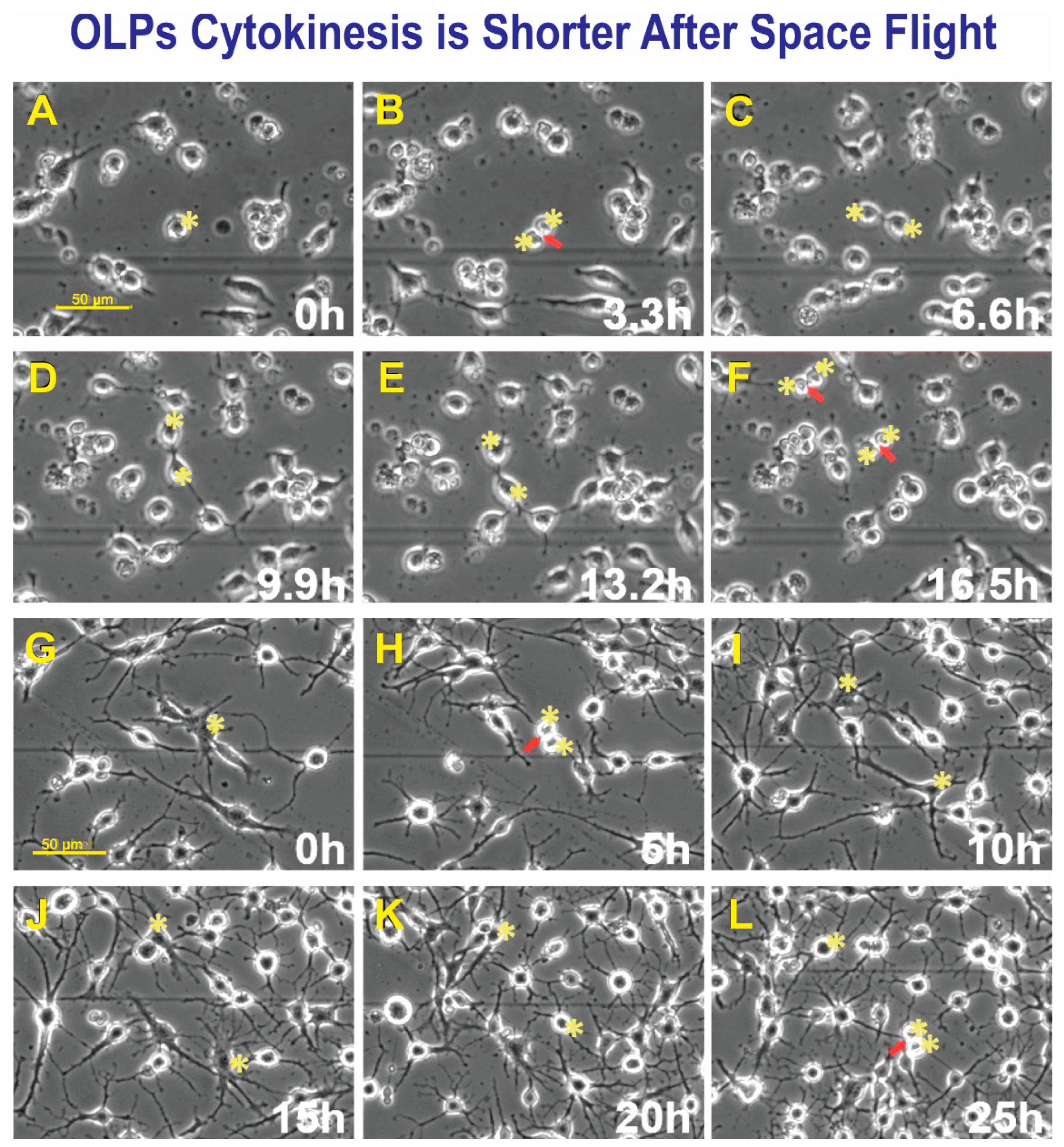
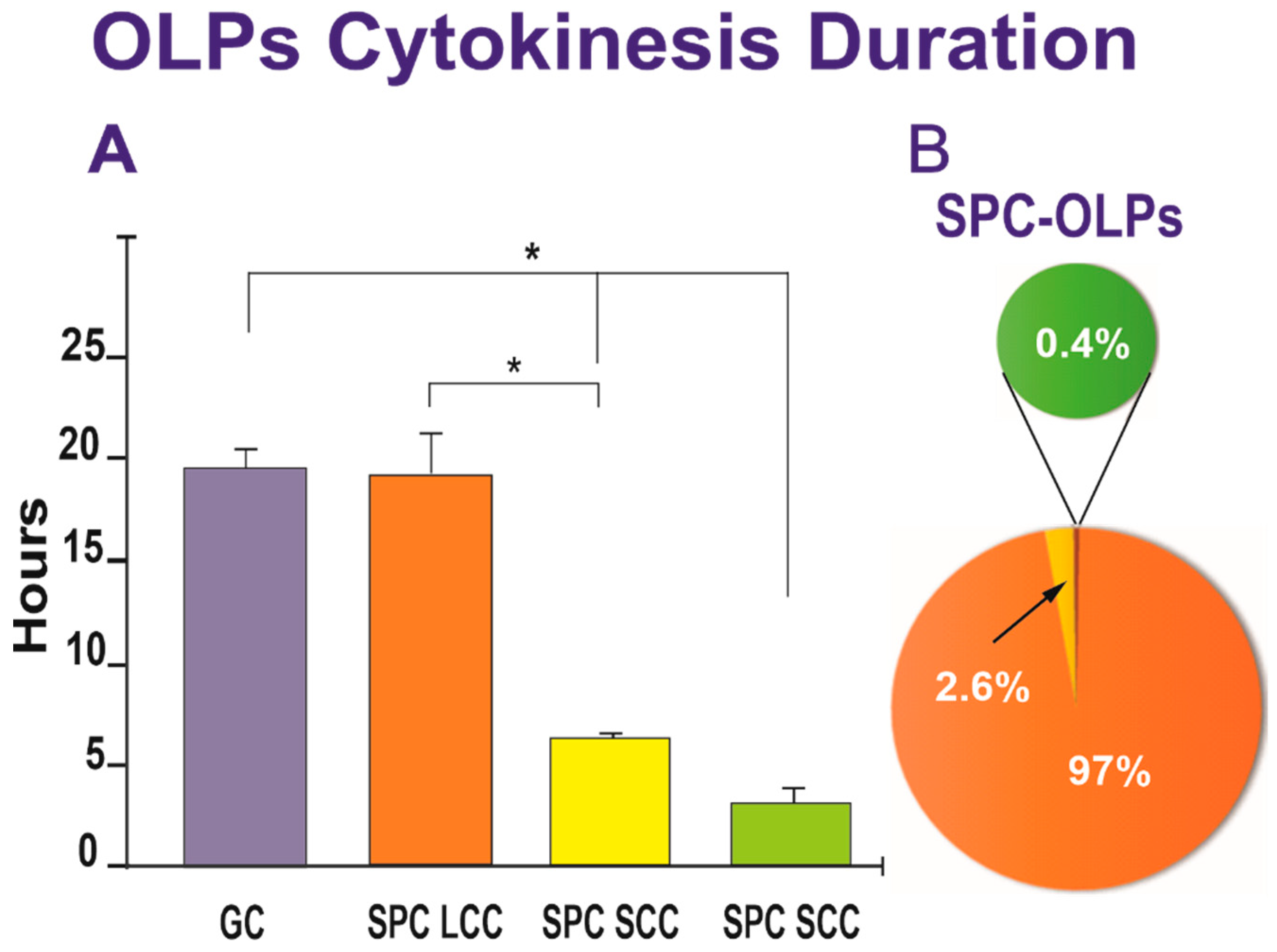
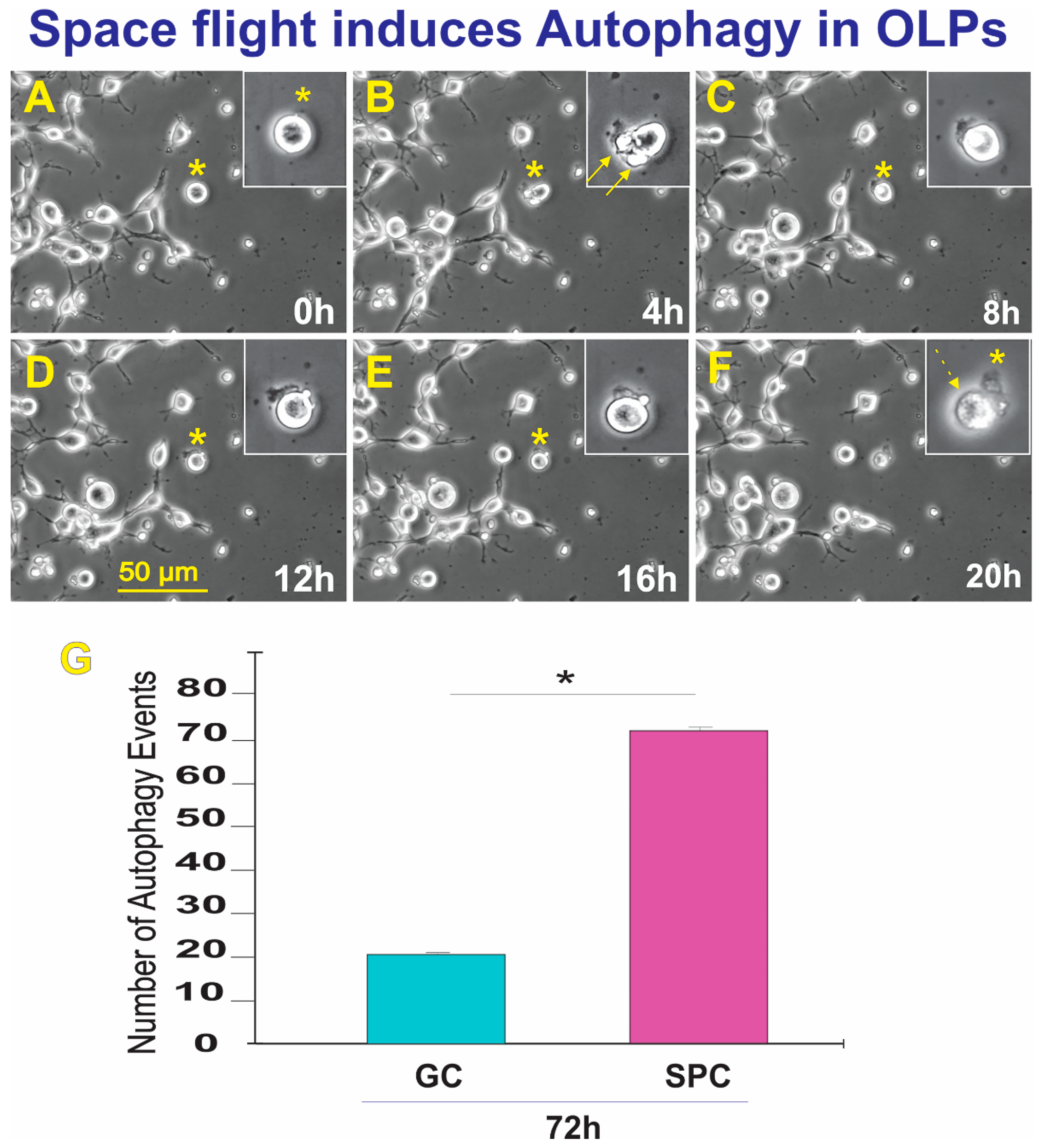
| Reagents | Measurements |
|---|---|
| Insulin | 5 mg |
| Transferrin | 50 mg |
| Putrescine | 16.1 mg |
| Sodium Bicarbonate | 2.2 g |
| D(+) galactose | 4.6 g |
| Kanamycin | 8 µg |
| * Sodium selenite | 0.8 mg/mL |
| SPC-OLPs > GC-OLPs | |||
|---|---|---|---|
| Relativity | Gene | Accession No. | Top Ranked Protein Name [Species] |
| 6.8 | HSP90AB1 | HS90B_HUMAN | Heat shock protein HSP 90-beta OS = Homo sapiens OX = 9606 GN = HSP90AB1 PE = 1 SV = 4 |
| 5.2 | SPARC | SPRC_HUMAN | SPARC OS = Homo sapiens OX = 9606 GN = SPARC PE = 1 SV = 1 |
| 4.7 | HSP90B1 | ENPL_HUMAN | Endoplasmin OS = Homo sapiens OX = 9606 GN = HSP90B1 PE = 1 SV = 1 |
Disclaimer/Publisher’s Note: The statements, opinions and data contained in all publications are solely those of the individual author(s) and contributor(s) and not of MDPI and/or the editor(s). MDPI and/or the editor(s) disclaim responsibility for any injury to people or property resulting from any ideas, methods, instructions or products referred to in the content. |
© 2023 by the authors. Licensee MDPI, Basel, Switzerland. This article is an open access article distributed under the terms and conditions of the Creative Commons Attribution (CC BY) license (https://creativecommons.org/licenses/by/4.0/).
Share and Cite
Tran, V.; Carpo, N.; Cepeda, C.; Espinosa-Jeffrey, A. Oligodendrocyte Progenitors Display Enhanced Proliferation and Autophagy after Space Flight. Biomolecules 2023, 13, 201. https://doi.org/10.3390/biom13020201
Tran V, Carpo N, Cepeda C, Espinosa-Jeffrey A. Oligodendrocyte Progenitors Display Enhanced Proliferation and Autophagy after Space Flight. Biomolecules. 2023; 13(2):201. https://doi.org/10.3390/biom13020201
Chicago/Turabian StyleTran, Victoria, Nicholas Carpo, Carlos Cepeda, and Araceli Espinosa-Jeffrey. 2023. "Oligodendrocyte Progenitors Display Enhanced Proliferation and Autophagy after Space Flight" Biomolecules 13, no. 2: 201. https://doi.org/10.3390/biom13020201
APA StyleTran, V., Carpo, N., Cepeda, C., & Espinosa-Jeffrey, A. (2023). Oligodendrocyte Progenitors Display Enhanced Proliferation and Autophagy after Space Flight. Biomolecules, 13(2), 201. https://doi.org/10.3390/biom13020201




